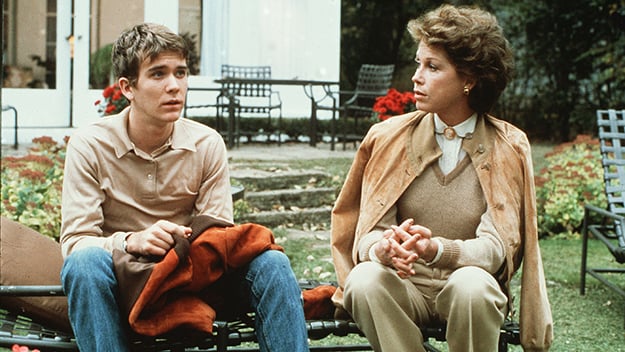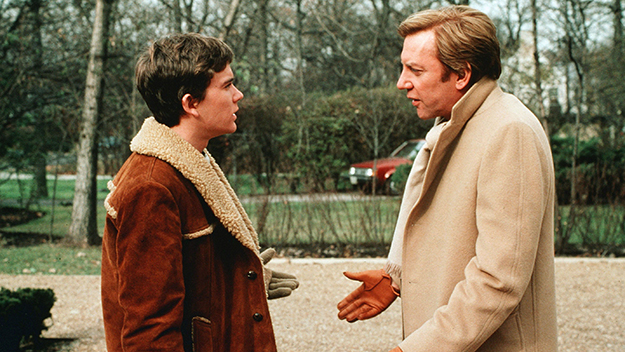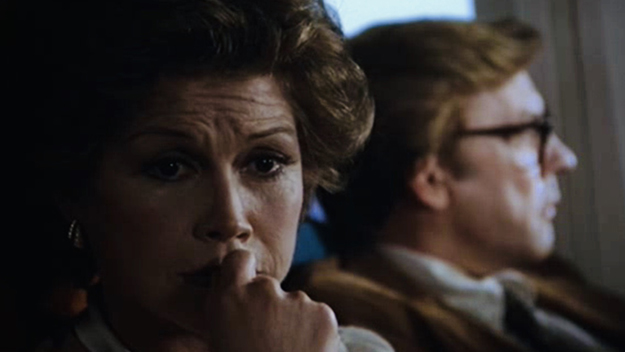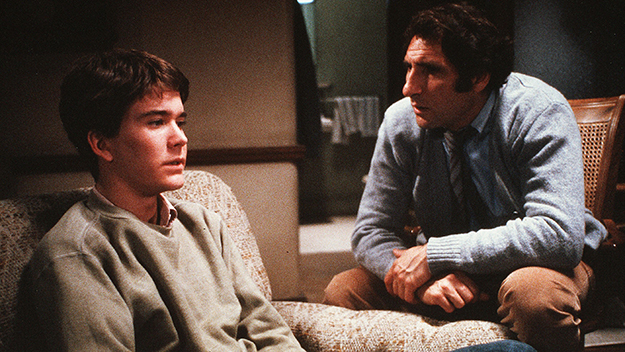Feeling Seen: Ordinary People
Feeling Seen is a regular column focusing on personal reflections on films from different authors and writers.

Timothy Hutton, Mary Tyler Moore in Ordinary People (Robert Redford, 1980)
The cover of the August-September 1980 issue of Film Comment is emblazoned with a familiar face, eyebrows dripping with sweat, eyes screwed in concentration, a scowl painted on Robert DeNiro’s twisted mug as he circles the ring in Martin Scorcese’s Raging Bull (1980). It’s an iconic performance with a rightful place in film canon. And yet, another film took home the Academy Award for Best Picture at that year’s Oscars: Robert Redford’s Ordinary People.
“Skip . . . if you’re not interested in mopey, repressed rich folks,” The New York Times viewer guide wryly advises. That year, Ordinary People would also beat out David Lynch’s The Elephant Man and Roman Polanski’s Tess; in an episode of Lynch on Lynch, Mel Brooks tells David Lynch “that in about ten years, Elephant Man will be remembered and Ordinary People will pretty much be relegated to an answer on a Trivial Pursuit card.”
Based on Judith Guest’s 1976 novel of the same name, Redford’s drama explores the suburban lives of Beth (Mary Tyler Moore) and Calvin (Donald Sutherland) Jarrett, a bourgeois white couple and the aftermath of a suicide attempt by their son Conrad (Timothy Hutton). Portraying a young life marked by such trauma—in this case, the death of Conrad’s brother Bucky, as well as his depression, despondency at school, sexual frustration, and entry into psychotherapy—was remarkable territory for a major motion picture at the time. If the 1980s were the years of the insufferable teenager, then Ordinary People was refreshing in the color it gave its young characters. The film earned Hutton, then just 20, an Academy Award, making him the youngest person in history to win for Supporting Actor.
But following that lionization, the consensus was that Ordinary People would age—or already had aged!—poorly, that it was plagued by a “treacly sentimentality,” or was one-note, too obsessed with the fashionable lives of the upper-middle class. Even the film’s invocation of the terminology of “ordinary people” ties it to a racial politics and social lineage that we are only now in the process of examining.
Ditto for women. Both film and book describe a developmental arc for Conrad: from the physical coldness of his mother to the warmth of his father; from the verbal restraint of his mother to the expansiveness of therapy with his psychiatrist Dr. Berger (Judd Hirsch); from repressed sexuality to erotic awakening spurred by his budding relationship with classmate Jeannine (Elizabeth McGovern). In all cases, these developments come at the expense of the film’s female characters, most of whom end up dead or banished. Victoria Szabo and Angela Jones write in an essay called “The Uninvited Guest” published in the Vision/re-vision feminist anthology, that “the subjectivity of all of the female characters is always filtered through the governing consciousness of the male characters.”
This tripartite condemnation—classist, out-of-touch, and misogynistic—is intended to be the final nail in the coffin for Ordinary People. And yet, it’s a film I can’t quite shake, returning to it many times as I have grown older, developing a deeper and more conflicted perspective on it with each viewing.

Timothy Hutton and Donald Sutherland in Ordinary People (Robert Redford, 1980)
“Fairy. Fag.” Conrad is self-abusing, tucked away in bed, humping his mattress.
Judith Guest’s novel gives clues about Conrad’s internalized homophobia: his brother taunts him, “Take it, fag, it’s a fag sweater, you’ll look great in it.” Conrad comes to connect his frailty and femininity to his passive experiences of sexuality, and the social cataclysm of his suicide attempt becomes an opportunity for him to learn to communicate. I attended an all-boy high school, and these expressions are familiar: internalizing one’s inability to sleep with women as self-hatred, responding to failure with physical violence, attempting to fix things only after they’re broken.
Conrad’s experiences also feel very… gay. Writing about “queer coding” in The Sundae, Dean Buckley laments the practice of understanding villainy through stereotypically queer traits like effeminacy in men or gender ambiguity. Instead, he suggests an exigency: write about queer-coded heroes, rare as they are, citing “Tonks from Harry Potter, Gale from Breaking Bad, and Conrad from Ordinary People.”
Not that there has been an absence of media “queering” exercises, but how might the film have been different had Conrad been closeted? How might it change his relationship to bullying, to dating, to his emotions? Stumbling upon chat forums whispering about the film, I saw the stories of gay boys—now gay men—identifying with Conrad: the shame of the “closet,” the fear of disappointing the cohesion of the family, the guilt of never “measuring up” to parental expectations. “All of us middle-class gays of a certain age had families like that,” one commenter wrote. Another continues, “There was a wave of confession that swept all over the country around the time this movie came out.”
Contrary to existing narratives, Ordinary People does not depend on whiteness for its thematic coherency. Sure, how Arab families like mine process emotions can differ widely from the cool dispassion of the WASPy Jarretts, and their aversion to physical intimacy: “I can’t go around hugging everybody the way you do,” Beth tells Conrad. But many cultures relate to their repression, and in an immigrant family with a culturally cautious bent, coming out can be a challenging experience, full of the same self-doubt and sadness.
I discovered yet another blog post by a gay man, this time by self-titled “lifelong film fan,” Ken Anderson, who runs a website called “Dreams Are What Le Cinema Is For,” named after a lyric in the 1982 Broadway musical, Nine. Anderson writes:
“Although Ordinary People is one of the whitest movies ever made, I’ve always been able to identify with it because the image-conscious middle-class world it dramatizes is not at all different from my own childhood growing up as one of the few black families in an all-white neighborhood. In the assimilationist household I grew up in, upward mobility meant the strict adherence to respectability politics.”
The structure of Ordinary People lends itself to these reinterpretations. It was Redford’s first effort as a director, and he keeps it deliberately sparse, constricting the film to focus on how the characters cope and understand one another’s emotions. In Inside Daisy Clover (1965), Redford played a narcissistic Hollywood star and was reportedly “furious when re-editing explicitly designated his character as gay.” This is disappointing: He would go on to play a major role in the emergence of a putative “independent film” community in the United States and served as a founding stalwart for the Sundance Festival. How delicious might it be to christen him a queer director too?

Mary Tyler Moore and Donald Sutherland in Ordinary People (Robert Redford, 1980)
Mary Tyler Moore is scattering the ashes of her son. “It was a sunny day. The water was clear and high as I knelt over it. I opened the container and emptied it into the rushing water. What was meant to be a prayer became an outraged demand. ‘You take care of him,’ I screamed at the sky.”
There is no way to confront Ordinary People without “MTM.” Redford always wanted her for the role, yet he “auditioned every actress in Hollywood”—from Natalie Wood to Ann-Margret and Lee Remick—before returning to her. She claims that she based the character on her distant father, that the role was the “Holy Grail” of her career. But she herself could have just as easily been the inspiration: A cultural moderate and political conservative who endorsed many a Republican president, Moore’s busy work schedule alienated her from her son, who struggled with drug abuse.
There is also no way to understand queer identification with Ordinary People without understanding the way Moore’s work was received. Before the film, she’d played an amiable Laura Petrie and a plucky Mary Richards; she was famous for her comedic roles, and the hosting of her eponymous show from 1970 to 1977. But those who describe Moore’s turn in Ordinary People as a departure miss the point; in a “Lives They Lived” obituary written for the New York Times, Taffy Brodesser-Akner describes Redford looking out on the beach at his home in Malibu and seeing Moore taking walks, where she seemed like such a “sad figure . . . so different from the spunky and triumphant walks she took in the opening credits of The Mary Tyler Moore Show.”
Moore, who passed away three years ago, is astounding in Ordinary People. At every point where the film could have swerved into melodrama, there she is, resolute, wrenching. There’s pain in the stiffness of her back, love in the wringing of her hands. For many, hers is an “evil” role, one filled with dispassionate judgment. It’s also an easy one for queer men to affix their own family traumas to. In a way, this is a failing of the film and its embrace of the villain-mother stereotype, as the traditional structure of victimizing father, victimized child, and sublime sufferer mother is altered in favor of a mother who can complement male emotional development.
A queer reading might suggest that the price for “curing” Conrad is the dissolution of the family. But this is an abdication of responsibility—as are the attempts to write Beth off as “icy” or a “bitch.” To me, she is a tragic character, the victim of her family’s orientation towards her suffering. Beth is regularly depicted as refusing to participate in the family unit, without a proper interrogation of the ways she is excluded and her behaviour is maligned, the ways in which Calvin and Conrad form a powerful alliance, and the ways in which the responsibility of holding the family together is foisted upon her.
Yes, a homophobic Beth troubled by the prospect of her sole remaining son being gay might alter our understanding of Conrad’s pain. But it also comes with a responsibility to admit that the queer male identification with Ordinary People cannot be fully separated from the misogyny of our community.

Timothy Hutton and Judd Hirsch in Ordinary People (Robert Redford, 1980)
I will never forget the scene where Calvin sits at the table in the dining room, and begins to cry after a particularly harsh fight with his wife. Teenage me was shocked, not just because of how rare it was to see male tears on the screen but, I realize now, because of what it portended for his marriage—men only allowing themselves to cry when it’s too late. He eventually approaches Dr. Berger, ostensibly to talk about Conrad, but eventually caves, saying “I think I came here to talk about me.” Simmering underneath the sparse language, you feel there is an interpersonal history between the characters, years of untold family stories built up and ossified.
The descriptions of Ordinary People often focus on its suburban setting. And yet describing an upbringing—like mine or like Conrad’s—as “suburban” often intends to convey an etymology of feeling or a sarcastic critique, and ignores that for many, suburban experiences are perfectly banal. For most of my life, my father would drive me to school from our home in the suburbs on his way to work at a hospital in downtown Toronto. During these rides we would bond, sharing stories and experiences that I would often be too tired to repeat at dinner with my mom and sister. I wondered whether similar dynamics were at play in my own family, whether the family subunit of my father and me—connected by language and temperament—seemed closed off to my mother, and whether this made her sad, or isolated.
I first watched Ordinary People at home, on the couch in our living room, with my mom and dad. It must have been playing on a cable rerun channel. My father is a psychiatrist and had heard of the film because it’s been used to teach about family systems in medical practice, being one of the most prominent representations of mental illness that doesn’t feature a shrink sleeping with their patients or being incompetent. Judd Hirsch, who plays Dr. Berger, is another former staple of TV comedy, having played Alex Rieger on Taxi. Berger—who is Jewish, as Beth notes somewhat judgmentally—plays foil to the Jarrett’s cultural conservatism, his foul-mouthed and aggressive questioning of Conrad pushing the teen to finally admit his inner demons in a moment of catharsis, yelling, “You just do one wrong thing!”
Ordinary People seeps into you, its conversations like the pain after a procession of quietly delivered slaps: “we just don’t connect”; “you drink too much at parties”; “it’s really important for you to hurt me”; “he thinks his mom hates him”; “why do you keep wanting to mess up your life?”. These took on a completely different meaning for me and for other boys coming to terms with their sexualities in sheltered households. In therapy, Calvin reflects on Beth:
Calvin: I can see her not being able to forgive him.
Dr. Berger: For what?
Calvin: Oh, I don’t know exactly. Being too much like her? People always think her and Buck were alike. But it’s really her and Conrad.
To many, the film’s psychology now seems retrograde, ignoring what we know about system theory and the numerous ways that family members can influence one another, opting instead for the psychoanalytic tradition of holding the mother responsible for her son’s development. When she accidentally breaks a platter in the kitchen, Beth turns to her own mother and says, “You know, I think this can be saved. It’s a nice clean break.”
In a conversation with his friend Karen (Dinah Manoff), whom he met in the psychiatric ward, Conrad says he misses the hospital and its sheltering comfort. Now out, she tells him the drama club is putting on A Thousand Clowns. Then she smiles, adding, “Conrad. Let’s have a great Christmas. Let’s have . . . a great year. Let’s have the best year of our whole lives. We can, you know . . . this could be the best one ever.” It’s a chilling coda, some of the last words Karen will speak to Calvin before relapsing and killing herself.
What was Conrad’s one wrong thing, and what was mine? When I started therapy, I found myself replaying the film in my head; the promise of getting better a subsidiary to the process of getting better. Berger adds, “Quitting wouldn’t look good. But how does it feel!?”—death, like disappointment, always hovering at the periphery.
Karen helps teach that the process of recovery is fundamentally about autonomy, about understanding the consequences of one’s actions, about revisiting one’s obligations to one’s parents. It’s also about survival:
Karen: Did it hurt?
Conrad: I don’t remember really.
Karen: You don’t want to talk about it?
Conrad: I never really talked about it. To doctors. But, not to anyone else. You’re the first who’s asked.
Karen: Why’d you do it?
Conrad: I don’t . . . It was like . . . falling into a hole. It keeps getting bigger and bigger and you can’t escape. And all of a sudden, it’s inside . . . and you’re the hole. You’re trapped. And it’s all over. Something like that.
And then he adds, “It’s not really scary . . . except when you think back on it.”
Kaleem Hawa (@kaleemhawa) writes about film and books.







